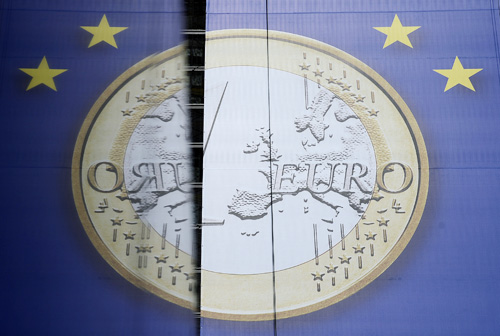|
 |
|
SAVE EURO: A picture of a euro displayed in Brussels, Belgium. The euro zone is fighting to avoid collapse (WU WEI) |

The global financial crisis is in its fifth year since the outbreak of the U.S. sub-prime mortgage fiasco of 2007. Despite efforts—conventional or otherwise—by the world's major economies to curb the crisis and stimulate growth, the global economy recovery still lags. The world economy is now at a crossroad similar to that in 2008. Lou Jiwei, Chairman of China Investment Corp., shared his views with Caijing magazine. Edited excerpts follow:
ECB's role
In mid-June, Greece elected a new government that supported austerity measures and a bailout plan. In July, the euro zone approved the 100-billion-euro bailout for Spanish banks. The pressure of a euro zone collapse, which would dramatically impact the global financial markets, seemed to wane. European Central Bank (ECB) President Mario Draghi's pledge to "do whatever it takes to preserve the euro" at the end of July and the recently announced Outright Monetary Transactions (OMTs) further reduced the risks of potential collapse.
Through OMTs, the ECB is committed to intervening in the sovereign debt market with infinite firepower if necessary, with the aim of stabilizing the financial system and safeguarding an appropriate monetary policy transmission. This means that if the crisis further intensifies, the ECB will act.
The ECB will assume the role as the final creditor, which is of vital importance to maintaining financial stability. It should not only be the final creditor to the banking system but also the final creditor in the government bond market.
A country that can make independent decisions on monetary and fiscal policies can ensure a liquidity demand of payment for any sovereign debt in its home currency, implicating the role of the central bank as the final creditor in the government bond market. It also implies that such a role can be played only when an economic crisis occurs and the government faces huge difficulties.
But in the euro zone, various member states have the same currency, yet different fiscal policies. This means the central bank cannot be the final creditor. Therefore, the sovereign debt markets within the monetary union are more fragile to the impact of a liquidity crisis.
From the intermittent and opaque Security Market Program to the clearly infinite OMTs, the ECB has made active steps toward being the final creditor in the sovereign debt markets of its member states. Since Draghi's speech at the end of July, the debt returns rates and market fluctuations in the periphery countries have seen a marked decline, reflecting a positive response in the market to the ECB's policies.
Will the European debt crisis reach a turning point? Further observations are needed.
The cause of the European sovereign debt crisis is largely due to the structural imbalance of euro zone member states. That is, each member state pursues an independent fiscal policy despite sharing a common currency.
A successful monetary union requires identifying differences in how the economies are structured among member states. Member states differ in terms of economic development, politics and culture. Before the crisis, the monetary policy of the euro zone was too relaxed in the southern states, leading to an excessive accumulation of debt in both the public and private sectors. In these countries, demand expanded excessively and labor costs increased while competitiveness declined, eventually leading to the European sovereign debt crisis.
| 